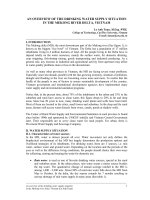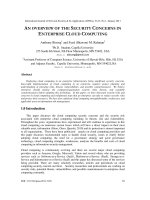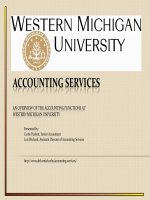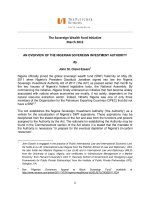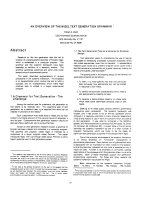An overview of the clinical management of spasticity
Bạn đang xem bản rút gọn của tài liệu. Xem và tải ngay bản đầy đủ của tài liệu tại đây (76.67 KB, 8 trang )
1
An overview of the clinical
management of spasticity
Michael P. Barnes
Spasticity can cause significant problems with activ-
ity and participation in people with a variety of neu-
rological disorders. It can represent a major chal-
lenge to the rehabilitation team. However, modern
approaches to management, making the best use of
new drugs and new techniques, can produce signif-
icant benefits for the disabled person. The details of
these techniques are outlined in later chapters and
each chapter has a thorough reference list. The pur-
pose of this initial chapter is to provide a general
overview of spasticity management, and it attempts
to put the later chapters into a coherent context.
Definitions of spasticity and the upper
motor neurone syndrome
Spasticity has been given a fairly strict and nar-
row physiologically based definition, which is now
widely accepted (Lance, 1980):
Spasticity is motor disorder characterised by a veloc-
ity dependent increase in tonic stretch reflexes (muscle
tone) with exaggerated tendon jerks, resulting from hyper-
excitability of the stretch reflex, as one component of the
upper motor neurone syndrome.
This definition emphasizes the fact that spasticity is
only one of the many different features of the upper
motor neurone (UMN) syndrome. The UMN syn-
drome is a somewhat vague but nevertheless useful
concept. Many of the features of the UMN syndrome
are actually more responsible for disability, and con-
sequent problems of participation, than the more
narrowly defined spasticity itself. The UMN syn-
drome can occur following any lesion affecting some
or all of the descending motor pathways. The clini-
cal features of the UMN syndrome can be divided
into two broad groups – negative phenomena and
positive phenomena (Table 1.1).
Negative phenomena of the UMN syndrome
The negative features of the UMN syndrome are
characterized by a reduction in motor activity. Obvi-
ously this can cause weakness, loss of dexterity and
easy fatiguability. It is often these features that are
actually associated with moredisabilitythanthepos-
itive features. Regrettably the negative phenomena
are also much less easy to alleviate by any rehabili-
tation strategy.
Positive phenomena of the UMN syndrome
These features can also be disabling but neverthe-
less are somewhat more amenable to active inter-
vention. At the physiological level thereareincreased
tendon reflexes, often with reflex spread. There is
usually a positive Babinski sign and clonus may be
elicited. These may be important diagnostic signs for
the physician but are of little relevance with regard
to the disability. The exception is sometimes the
presence of troublesome clonus. This can be trig-
gered during normal walking, such as when stepping
off a kerb, or can occasionally occur with no obvi-
ous trigger, such as in bed. In these circumstances
clonus can sometimes be a significant disability and
1
2 Michael P. Barnes
Table 1.1. Features of the upper motor neurone
syndrome
Negative Positive
r
Muscle weakness
r
Increased tendon reflexes with
radiation
r
Loss of dexterity
r
Clonus
r
Fatiguability
r
Positive Babinski sign
r
Spasticity
r
Extensor spasms
r
Flexor spasms
r
Mass reflex
r
Dyssynergic patterns of
cocontraction during movement
r
Associated reactions and other
dyssynergic and stereotypical
spastic dystonias
occasionally needs treatment in its own right. The
other positive features of the UMN syndrome cause
more obvious disability.
Spasticity
A characteristic feature of spasticity is that the hyper-
tonia is dependent upon the velocity of the muscle
stretch – in other words, greater resistance is felt with
faster stretches (this results in the clinical sign of a
‘spastic catch’). Thus, spasticity resists muscle
stretch and lengthening. This has two significant
consequences. First, the muscle has a tendency to
remain in a shortened position for prolonged peri-
ods, which in turn may result in soft tissue changes
and eventually contractures (Goldspink & Williams,
1990). The second consequence is that attempted
movements are obviously restricted. If, for exam-
ple, the individual attempts to extend the elbow by
activation of the triceps, this will stretch the biceps,
which in turn will induce an increase in resistance
and indeed may prevent full extension of the elbow.
However, it is worth emphasizing that the situa-
tion is usually more complex. In the above example,
relief of the spasticity in the biceps may not lead to
improvement in the function of the arm, as other
features of the UMN syndrome, particularly muscle
weakness, may have a part to play.
Soft tissue changes and contractures
Restriction of the range of movement is not always
simply due to increase of tone and spasticity in
the relevant muscles. The surrounding soft tissues,
including tendons, ligaments and the joints them-
selves, can develop changes resulting in decreased
compliance. It is likely that such contractures and
changes in the soft tissues arise from the muscle
being maintained in a shortened position. It is pos-
sible, but not absolutely proven, that maintaining a
joint through a full range of movement may prevent
the longer-term development of soft tissue contrac-
tures. The frequency of the stretch, either actively
or passively, that is required to prevent contractures
is unknown. However, it is important to emphasize
good posture and seating such that the muscles, as
far as possible, are maintained at full stretch for at
least some of every day. The recommendation is that
muscles be put through a full stretch for 2 hours
in every 24 hours (Medical Disability Society, 1988).
However, more research is needed in this field to
determine the degree and frequency of stretch with
more certainty.
Thus, hypertonia often has both a neural com-
ponent (secondary to the spasticity) and a biome-
chanical component (secondary to the soft tissue
changes). Obviously biomechanical hypertonia is
not velocity dependent and restricts movements
even at slow velocities. Furthermore, biomechanical
hypertonia will not respond to antispastic agents; the
only treatment possibilities relate to physiotherapy,
stretching, good positioning, splinting and casting.
Ultimately surgery may be needed to relieve advanc-
ing and disabling soft tissue contracture. In practical
terms there is often a mixture of neural and biome-
chanical hypertonia, and it is very difficult clinically
to determine the relative contribution of each of the
components. Thus, active intervention for spastic-
ity (e.g. by antispastic medication or local treatment
such as phenol block or botulinum toxin injection)
An overview of the clinical management of spasticity 3
is worth undertaking simply to be sure of alleviat-
ing at least the neural component of the hypertonia.
Thereis often a gratifying response even in limbs that
appear to have fixed contractures.
In advanced spasticity, it is often the soft tissue
changes that contribute most to the disability and are
resistant to treatment. Increasing deformity of the
limbs will clearly lead to rapidly decreasing function
and often result in problems with regard to hygiene,
positioning, transferring and feeding and make the
individual more prone to pressure sores (O’Dwyer
et al., 1996).
Flexor and extensor spasms
Severe muscle spasms are often found in UMN syn-
drome. These can be in either a flexor pattern or an
extensor pattern.
The commonest pattern of flexor spasm is flexion
of the hip, knee and ankle. The spasms can some-
times occur spontaneously or, more commonly,
in response to stimulation, are often mild. Sim-
ple movement of the legs or adjusting position in
a chair can be enough to induce the spasm. The
spasms themselves can be painful and are some-
times so frequent and severe that a permanent state
of flexion is produced. If spasms worsen suddenly,
it is worth looking for aggravating factors such as
pressure sores, bladder infections, irritation from a
catheter or even such apparently mild stimulants
suchasanill-fittingorthosisoratight-fittingcatheter
leg bag. Occasionally constipation or bladder reten-
tion can also produce a flexor spasm, which can then
be associated with a reflex emptying (mass reflex) of
the bowel or bladder.
Similar problems can occur with extensor spasms,
which are commonest in the leg and involve exten-
sion of the hip and knee with plantar flexion and
usually inversion of the ankle. Once again, such
spasms can be triggered by a variety of stimuli and
sometimes can be so severe as to produce a perma-
nent extensor position. Extensor spasms are proba-
bly more common than flexor spasms in incomplete
spinal cord lesions and cerebral lesions, but there
is no clear association with any particular pathology.
Occasionally a spasm can be useful from a functional
point of view. Placing pressure on the base of the foot
in order to stand can sometimes produce a strong
extensor spasm of the leg, effectively turning it into
a rigid splint, which, in turn, aids walking. Occasion-
ally individuals can make positiveuseofself-induced
spasms, such as for putting on trousers. This empha-
sizes the importance of detailed discussion with the
disabled person and his or her carer before assuming
that the spasm will need treatment. Finally, extensor
and flexor spasms can be extremely painful; even if
not causing undue functional disturbance, they can
need treatment in an attempt to relieve the associ-
ated acute pain.
Spastic dystonia and associated reactions
Most of the previously described positive phenom-
ena of the UMN syndrome can occur at rest. Another
range of problems can occur on movement. For
example, there is the classic hemiplegic posture,
commonly occurring in stroke, that often occurs
when the individual tries to walk. This posture con-
sists of a flexed, adducted, internally rotated arm
with pronated forearm and flexed wrist and fin-
gers. The leg is extended, internally rotated and
adducted, and the ankle is plantar flexed and
inverted, often with toe flexion. Other patterns
occurring on movement are sometimes called spas-
tic dystonias (Denny-Brown, 1966). This is a term
that probably ought to be avoided, given the poten-
tial confusion with extrapyramidal disease.
Other problems that occur on movement or
attempted movement involve co-contraction of the
agonist and antagonists. Simultaneous contraction
of agonist and antagonist muscles is a normal motor
phenomenon and is required for the smooth move-
ment of the limb. However, in the UMN syndrome,
agonist and antagonist muscles may co-contract
inappropriately and thus disrupt normal smooth
limb movement (Fellows et al., 1994). Sometimes
involuntarily activation of muscles remote from the
muscles involved in a particular task also contract.
For example, if the individual attempts to move an
arm, then a leg may extend or flex. Conversely the
4 Michael P. Barnes
arm can flex when attempting to walk (Dickstein
et al., 1996). These ‘associated reactions’ (Walshe,
1923) can interfere with walking by unbalancing
the individual or, for example, making it impossi-
ble to do any task with the arms while standing.
Various other patterns of dyssynergic and stereo-
typical contractions have been described, such as
extensor thrust (Dimitrijevic et al., 1981). However,
the labelling of these problems is less helpful than a
prolonged period of observation and discussion with
the disabled person, the family and the person’s car-
ers. Simple bedside testing is usually inadequate to
determine an overall treatment strategy. The pattern
of spasticity and the functional consequences dur-
ing attempted movement as well as at rest all need
careful assessment, often over prolonged periods of
time. Reports from a well-educated disabled person
who can describe the problems in different circum-
stances are of far more value than a single examina-
tion in the outpatient clinic.
Clinical consequences
The above description of the different patterns of the
UMN syndrome make it clear that there is a poten-
tially wide range of functional problems. In order
to draw the discussion together, the major conse-
quences can be annotated as follow.
Mobility
Probably the most common consequence of the
UMN syndrome is difficulty walking. The gait can be
clumsy and uncoordinated, and falling can become
a common event. Eventually walking may become
impossible owing to a combination of soft tissue con-
tractures, flexor or extensor spasms and unhelpful
associated reactions. It is also worth bearing in mind
that individuals with UMN syndrome may often
have a whole variety of other neurological problems,
such as cerebellar ataxia or proprioceptive distur-
bance, which further compounds the problem. Even
if the individual cannot walk, the UMN syndrome
can cause further problems with regard to difficulty
maintaining a suitable seating posture. Spasticity
may make it difficult to self-propel a wheelchair.
Extensor spasms may constantly thrust the individ-
ual forward while sitting in the chair, giving rise to
an increased risk of shear forces that can cause pres-
sure sores. Seating will often require a considerable
range of bracing, supports and adjustments in order
to allow the person to maintain a useful and com-
fortable position.
Loss of dexterity
Inthe arm, the UMN syndrome can cause further dif-
ficulties with, for example, feeding, writing, personal
care and self-catheterization. Mobility in bed may
be hampered and loss of dexterity in the arm may
make it difficult to self-ambulate in a wheelchair. All
these problems can slowly lead to decreased inde-
pendence and a consequent increased reliance on a
third party.
Bulbar and trunk problems
Although most of the functional consequences of
spasticity occur in the arm or leg, it is worth remem-
bering that truncal spasticity can cause problems
with seating and maintaining an upright posture –
necessary for feeding and communication. Bulbar
problems can give rise to difficulty swallowing, with
consequent risk of aspiration or pneumonia. Further
problems can arise with communication, secondary
not only to inappropriate posture but also to spastic
forms of dysarthria.
Pain
It is not widely recognized that spasticity and the
other forms of UMN syndrome can be extremely
painful. This is particularly the case with flexor
and extensor spasms, and sometimes treatment is
needed simply for analgesia rather than improve-
ment of function. Abnormal postures can also give
rise to an increased risk of musculoskeletal prob-
lems and osteoarthritic change in the joints. Any
peripheral stimuli from problems such as ingrowing
An overview of the clinical management of spasticity 5
toenails or small pressure sores can, in turn, exacer-
bate the spasticity, and a vicious circle of increased
pain and increased spasticity can ensue.
Carers and nursing problems
Spasticity is one of the unusual conditions that can
sometimes require treatment of the disabled per-
son for the sake of the carer. Individuals, particularly
with advanced spasticity, can be extremely difficult
to move and nurse. Transfers from bed to toilet or
bed to wheelchair can be laborious. Hygiene can be
a problem with, for example, marked adductor spas-
ticity, causing problems with perineal hygiene and
catheter care. Flexion of the fingers can cause partic-
ular difficulties with hygiene in the palm of the hand.
Thus, aggressive treatment of spasticity can some-
times be a factor in reducing carer stress, which in
turn can make the difference between the individual
remaining at home or moving into an institution.
An approach to management
The previous section indicated the complexity and
functional consequences of spasticity. The following
chapters in the book outline the detail of the dif-
ferent approaches to the management, but this sec-
tion attempts to provide an overview of the process
(Fig. 1.1).
Aims of treatment
The first question to ask is whether treatment is
needed at all. The previous section has shown that
occasionally a spastic pattern can be functionally
useful, such as an aid to walking or dressing. Spas-
ticity in the UMN syndrome may be abnormal from
a neurophysiological point of view, but this does not
mean that treatment is always required. The aims of
treatment will always need careful annotation and
discussion with the individual. The commoner aims
are to improve a specific function, reduce pain, ease
the task of caring or prevent long-term problems,
such as soft tissue contractures. The specific aims
of a particular treatment strategy always need clear
explanation. This also implies that there should be
an appropriate method of measuring outcome, so
that one knows when the aim is fulfilled. Chapter
3 discusses the topic of measurement in spasticity.
Outcomes clearly need to be geared to the aim of
treatment. For example, if the aim of the treatment
is to improve hand function, a simple, reproducible
and valid test of hand function will be required. If
the outcome is a reduction of pain, perhaps use of
a visual analogue scale will be helpful. The use of
a global disability or activities of daily living (ADL)
scale is usually inappropriate, as subtle treatment
effects may be masked.
It is important, particularly in people needing
long-term treatment, that the aims and purposes of
treatment be reviewed regularly and new goals set or
old goals adjusted. This is particularly the case with
the use of long-term antispastic medication when
the side effects of treatment may at some point out-
weigh its benefits (see Chapter 7).
Self-management
Education of the disabled person and his or her
family is vital, as in all rehabilitation management.
Spasticity and the UMN syndrome involve complex
phenomena. The individual needs to be aware of
some of the factors that may aggravate the prob-
lem, such as inappropriate positioning, tight-fitting
shoes, or even heavy bedclothes. A detailed appraisal
of the pattern of spasticity may enable the individ-
ual to relieve many of the functional problems. Both
the clinician and the individual should be aware of
potential aggravating factors, such as the worsening
effect on spasticity of bladder infection or constipa-
tion.
The physiotherapist and the orthotist
The early involvement of an experienced physio-
therapist is invaluable. There are many potential
interventions, ranging from simple passive range-of-
motion exercises to more complex antispastic phys-
iotherapy approaches (see Chapters 4 and 5). The
physiotherapist can also administer symptomatic


